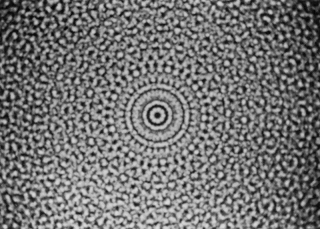Date: 19 June 2003 | Season: California Sound/California Image
CALIFORNIA CONSCIOUSNESS
Thursday 19 June 2003, at 7pm
London Barbican Screen
The California Dream became a psychedelic hallucination when eastern mysticism fused with drug-fuelled fantasy in the heady 60s & 70s. Transcend trance end.
James Whitney, Lapis, 1963-66, colour, sound, 10 min
Scott Bartlett, 1970, 1972, colour, sound, 29 min
James Broughton, This is it, 1971, colour, sound, 9 min
Jordan Belson, Re-Entry, 1964, colour, sound, 6 min
Pat O’Neill, 7362, 1965-67, colour, sound, 10 min
Gunvor Nelson, Take Off, 1972, b/w, sound, 10 min
Charles I. Levine, Apropo of San Francisco, 1968, colour, sound, 4 min
PROGRAMME NOTES
CALIFORNIA CONSCIOUSNESS
Thursday 19 June 2003, at 7pm
London Barbican Screen
LAPIS
James Whitney, 1963-66, colour, sound, 10 min
“Lapis was as close as I could come at the time of conceiving a totally balanced opposition of stasis and flow, holding the paradox symbolically through wave and particle, pointing to a still centre of emptiness. Both in stasis and time, Lapis conforms to the circular form of the mandala. Only at the end is there an off-centre parting of two central black-eyed forms, which allow an emptiness to pass through and return to the beginning image.” —James Whitney
1970
Scott Bartlett, 1972, colour, sound, 29 min
“1970 – the year of the moon shot; the year of the Bartlett’s only son, Adam; the year Scott’s life peaked in high harmony and discord with the American culture. This autobiographical film presented so thorough a summation of Bartlett’s personal work that it rendered him harmless for years to come.” —Canyon Cinema catalogue
THIS IS IT
James Broughton, 1971, colour, sound, 9 min
“James Broughton’s creation myth, This Is It, places a 2-year-old Adam and a bright apple-red balloon in a backyard garden of Eden, and works a small miracle of the ordinary. And since that miracle is what his film is about, he achieves a kind of casual perfection in matching means and ends.” —Robert Greenspun, The New York Times
RE-ENTRY
Jordan Belson, 1964, colour, sound, 6 min
“When Belson gave up filmmaking in the early sixties, he diverted his creative energy to the practise of Hatha yoga. When the Ford Foundation offered him one of their coveted $10,000 grants in 1964, he turned them down. But after reconsidering, he accepted the money and re-entered filmmaking with Re-Entry, the first of his ‘personal’ films. For Belson the opposition of impersonal to personal art does not indicate an antithesis of geometrical formalism to Expressionism. As a yogi, Belson seeks the transcendence of the self. His personal cinema delineates the mechanics of transcendence in the rhetoric of abstraction.” —P. Adams Sitney, Visionary Film
7362
Pat O’Neill, 1965-67, colour, sound, 10 min
“This is film as art in pure presentational form. Patrick O’Neill has utilised colour, sound and images in a symphonic mode, attacking the consciousness with unusual power. 7362 does not say anything, but simply is, in the way that a kaleidoscope is the shapes, images and colours presented to the eye. Groups who want to break away from seeing cinema as stories and morals will find this a stirring introduction to the real possibilities of the form.” —Christian Advocate
TAKE OFF
Gunvor Nelson, 1972, b/w, sound, 10 min
“For contemporary audiences, particularly student audiences, Take Off is confrontational on several levels simultaneously. First, the apparent over-exploitation of the ‘male gaze’ during much of the film seems particularly outré in a 1990s classroom (both for those who believe in the liberation of women’s bodies from male control and for those who are uncomfortable with nudity in film and in public), until the film’s final destination is clear, at which point we realise that the three women who collaborated on the film have raised the spectre of ‘the gaze’ only to dismantle it. Indeed, we recognise, once Ellion Ness has ‘taken it all off’, that her smiles at the camera are not the smiles of submission to male desire that we thought they were, but smiles of complicity with her two media-guerrilla collaborators and with all those watching who are aware of the implications of a dehumanising gaze. A second level of confrontation, which is at least as powerful now as it was in 1972, results from the decision to use a stripper who does not precisely conform to contemporary societal standards for beauty or eroticism.” —Scott MacDonald, A Critical Cinema 3
APROPO OF SAN FRANCISCO
Charles I. Levine, 1968, colour, sound, 4 min
“(After or for Jean Vigo) with Ben Van Meter. Sound recording by Bob Cowan. A study in visual rhythms and structure, using the same basic element repeated with variations.” —Charles I. Levine
Back to top
